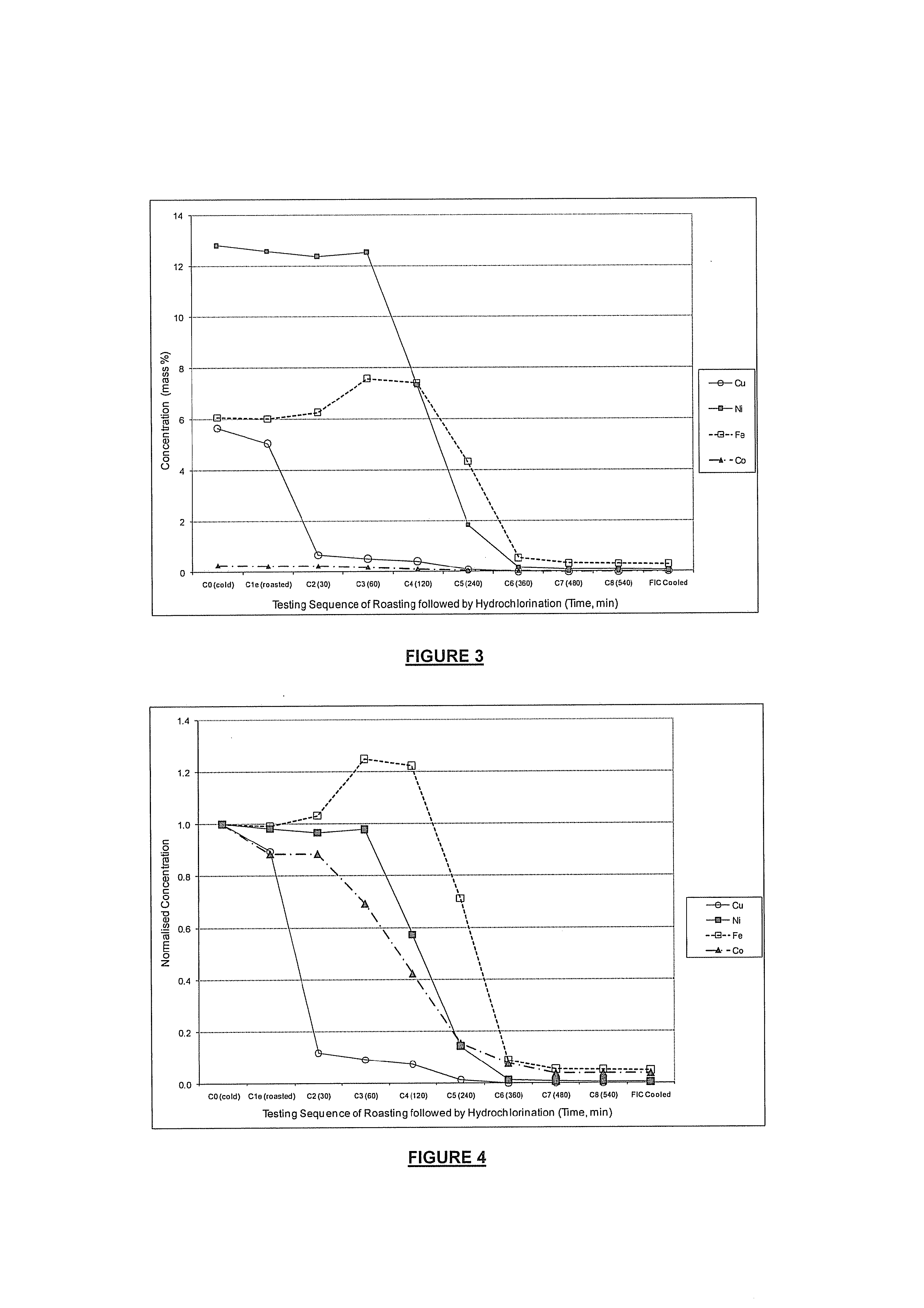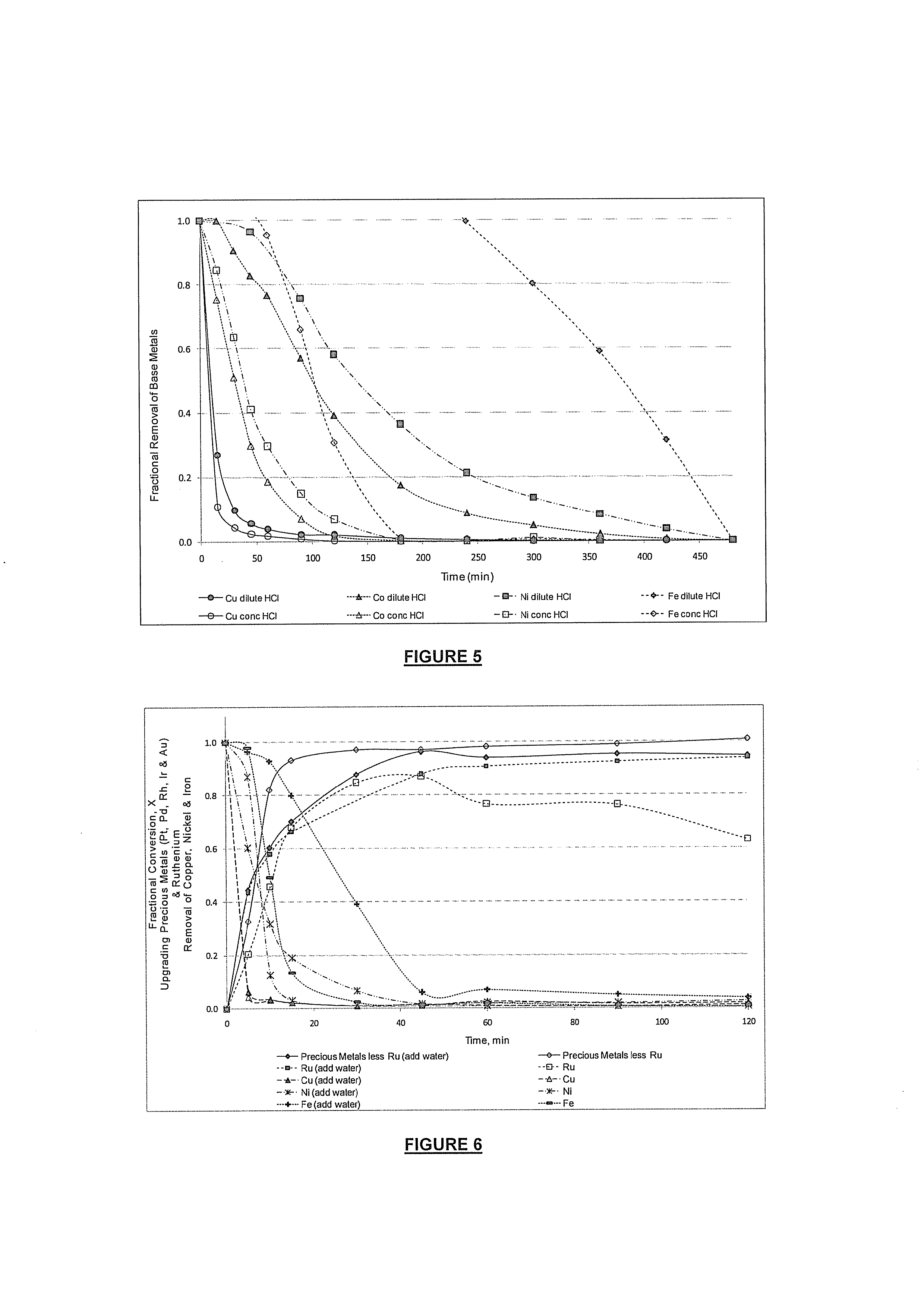Upgrading of precious metals concentrates and residues
a precious metals and concentrate technology, applied in the field of precious metals concentrates and residues, can solve the problems of significant complexity of the refining process, complex processing, and the need for significant stoichiometric excess of hydrogen chloride, so as to limit the loss of ruthenium and reduce the formation of precious metals chloride and resultant losses.
- Summary
- Abstract
- Description
- Claims
- Application Information
AI Technical Summary
Benefits of technology
Problems solved by technology
Method used
Image
Examples
example 1
[0072]A process used for upgrading a precious metals-containing concentrate (mass 1.5 g containing just over 50% precious metals) through oxidative pre-treatment followed by hydrochlorination with pure anhydrous hydrogen chloride gas was carried out as follows:[0073]1.5 g precious metals concentrate was located within an externally heated furnace and heated to a temperature of 600° C. under a nitrogen atmosphere;[0074]the gas was switched to air at 600° C. for 30 minutes to effect a pre-oxidative roast;[0075]the gas was then switched to nitrogen and the furnace heated to 950° C.;[0076]the gas was then subsequently switched to anhydrous hydrogen chloride for 1 hour to effect hydrochlorination;[0077]flushing and cooling under nitrogen to room temperature was then carried out.
[0078]The treated concentrate was substantially upgraded to almost 95% precious metals and substantially cleaned of impurities (see final treated concentrate analysis):
FeedTreated concentrateElementMass % composit...
example 2
[0079]A process for upgrading a precious metals-containing concentrate (mass 1.5 g of just over 50% precious metals) involving a hydrometallurgical oxidative pre-treatment, as opposed to a pyrometallurgical oxidative pre-treatment, followed by hydrochlorination was carried out as follows:[0080]hydrometallurgical oxidation of the precious metals concentrate by leaching in an oxygen-containing environment in an autoclave at a pressure of 18 bar and a temperature of 200° C. for over 2 hours;[0081]1.5 g of this hydrometallurgically treated precious metals concentrate was then located within an externally heated furnace and heated to a temperature of 1000° C. under a nitrogen atmosphere;[0082]the gas was switched to anhydrous hydrogen chloride for 1 hour to effect hydrochlorination;[0083]flushing and cooling under nitrogen to room temperature was then performed.
[0084]The treated concentrate was upgraded to greater than 95% precious metals (see final treated concentrate analysis):
FeedTrea...
example 3
[0086]A process in which reactant anhydrous hydrogen chloride gas was diluted with nitrogen to hydrochlorinate a precious metals concentrate (just over 50% precious metals) after pyrometallurgical oxidative pre-treatment was carried out as follows:[0087]1.5 g precious metals concentrate was heated within an externally heated furnace to 600° C. under a nitrogen atmosphere;[0088]the gas was switched to air at 600° C. for 30 minutes to effect a pre-oxidative roast;[0089]the gas was then switched to nitrogen and the furnace heated to 1000° C.;[0090]the gas was then subsequently switched to a mixture of anhydrous hydrogen chloride and nitrogen (in a volume ratio of 1:2) for 3 hours to effect hydrochlorination;[0091]flushing and cooling under nitrogen to room temperature was then carried out.
[0092]The treated concentrate was substantially upgraded to almost 95% precious metals and substantially cleaned of impurities (see final treated concentrate analysis):
FeedTreated concentrateElementMa...
PUM
| Property | Measurement | Unit |
|---|---|---|
| Temperature | aaaaa | aaaaa |
| Temperature | aaaaa | aaaaa |
| Temperature | aaaaa | aaaaa |
Abstract
Description
Claims
Application Information
 Login to View More
Login to View More - R&D
- Intellectual Property
- Life Sciences
- Materials
- Tech Scout
- Unparalleled Data Quality
- Higher Quality Content
- 60% Fewer Hallucinations
Browse by: Latest US Patents, China's latest patents, Technical Efficacy Thesaurus, Application Domain, Technology Topic, Popular Technical Reports.
© 2025 PatSnap. All rights reserved.Legal|Privacy policy|Modern Slavery Act Transparency Statement|Sitemap|About US| Contact US: help@patsnap.com



